When you install a new set of brake pads, it’s easy to assume that your braking system will immediately deliver peak performance. However, without properly bedding in your new brake pads, you could face noise, reduced braking efficiency, and even premature wear. The bedding-in process — also known as “breaking in” — is an essential step in ensuring your brake pads perform optimally and last as long as they should.
In this article, we’ll explain what bedding-in is, why it’s important, how to do it correctly, and what mistakes to avoid.
What Does “Bedding-In” Brake Pads Mean?

Bedding-in is the process of gradually conditioning both the brake pad surface and the rotor surface to ensure they work harmoniously together. This involves heating the pads and rotors through controlled braking, which transfers an even layer of friction material from the pad to the rotor.
This transfer layer:
-
Improves brake response
-
Prevents uneven pad deposits
-
Minimizes vibration and noise
-
Reduces the risk of rotor glazing or warping
Why Bedding-In Brake Pads Is Crucial
Skipping the bedding-in process can lead to a range of performance and safety issues.
Table: Consequences of Skipping Brake Pad Bedding
| Problem | Cause |
|---|---|
| Brake judder or vibration | Uneven transfer layer or pad material deposits |
| Squealing or grinding noises | Poor pad-to-rotor mating |
| Glazed pads or rotors | Excess heat from sudden hard braking |
| Reduced stopping power | Incomplete pad-to-rotor contact surface |
| Premature brake wear | Inconsistent wear due to uneven friction |
When to Bed-In Brake Pads
-
After installing new brake pads and rotors
-
After resurfacing rotors
-
When using high-performance or ceramic pads
-
After installing racing or heavy-duty pads
Note: Some OE or aftermarket pads may be pre-burnished, but even these can benefit from mild bedding.
How to Properly Bed-In New Brake Pads
The bedding-in process can vary depending on the type of vehicle and brake pad material. However, here is a general bedding-in procedure for most street vehicles:
Step-by-Step Bedding-In Guide:
-
Find a safe, open road or parking area
-
No traffic, pedestrians, or obstacles
-
-
Perform 5–6 moderate stops
-
From ~60 km/h to ~20 km/h
-
Use medium brake pressure
-
Do not come to a complete stop
-
Allow 30 seconds between each stop
-
-
Perform 3–4 harder stops
-
From ~80 km/h to ~20 km/h
-
Apply firm pressure but avoid ABS activation
-
Again, do not stop completely
-
-
Drive for 5–10 minutes at moderate speed
-
Avoid braking
-
This allows brakes to cool gradually
-
-
Let the vehicle sit for at least 1 hour
-
Do not park with hot brakes applied
-
Avoid brake hold (e.g., on a hill)
-
Note: Always follow manufacturer-specific instructions if available.
Tips for Successful Bedding-In
| Tip | Why It Matters |
|---|---|
| Do NOT come to a full stop during bedding | Prevents uneven pad deposits on hot rotors |
| Use gradual brake pressure | Reduces risk of pad glazing |
| Avoid aggressive braking for 300–500 km | Allows materials to cure fully |
| Choose the right environment | Traffic or hills can disrupt proper bedding |
Special Considerations for Different Pad Types
Ceramic Brake Pads
-
Require longer bedding-in due to harder material
-
More resistant to heat fade
-
Quieter and cleaner
Semi-Metallic Pads
-
Heat up quickly
-
Require moderate bedding with careful heat cycles
-
Excellent for performance or heavy vehicles
Performance / Racing Pads
-
Need aggressive bedding-in at high speeds
-
Not suitable for normal street bedding-in process
-
Often require specific break-in protocols
Bedding-In FAQ
Q: Can I bed-in new pads with old rotors?
A: It’s possible, but not ideal. Old rotors may already have uneven wear or embedded pad material. Always resurface or replace rotors when installing new pads.
Q: How do I know the pads are bedded-in?
A: Braking will feel smoother, quieter, and more responsive. You may also see a light blue or gray tint on the rotor surface — evidence of the transfer layer.
Q: What happens if I drive normally without bedding them in?
A: You risk uneven wear, noisy brakes, and longer stopping distances — especially during emergency stops.
Buy Quality Brake Pads for Best Results

To ensure a successful bedding-in process, it’s vital to use high-quality brake pads designed for your specific vehicle and driving needs.
Buy Car Brake Pads online — Choose from a wide selection of trusted, vehicle-specific brake pads to ensure safety, durability, and peak braking performance.
Conclusion
Bedding-in your new brake pads is not an optional step — it’s essential to guarantee safety, longevity, and optimal brake performance. By taking the time to properly break in your pads and rotors, you’ll enjoy smoother stops, quieter operation, and improved durability.
Whether you’re replacing worn pads or upgrading to performance brakes, don’t forget to bed them in properly. And for high-quality replacement parts at great prices, you can always
Buy Car Brake Pads online — trusted by mechanics and drivers alike.